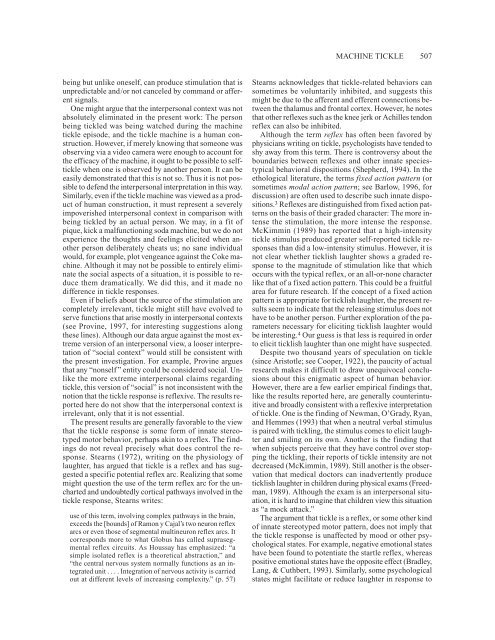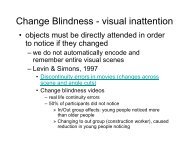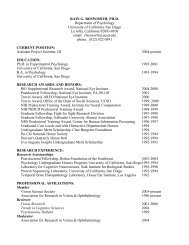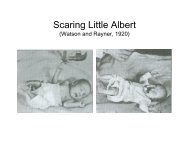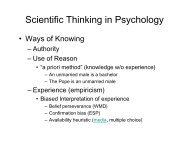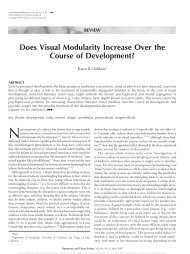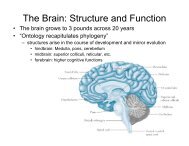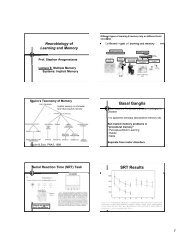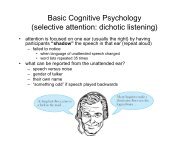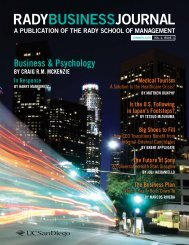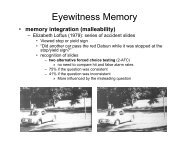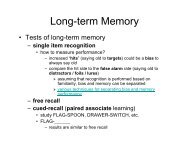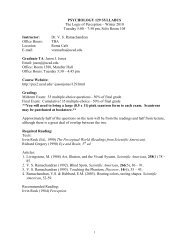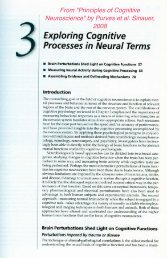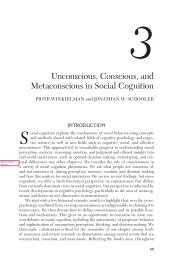Can a machine tickle?
Can a machine tickle?
Can a machine tickle?
You also want an ePaper? Increase the reach of your titles
YUMPU automatically turns print PDFs into web optimized ePapers that Google loves.
eing but unlike oneself, can produce stimulation that is<br />
unpredictable and/or not canceled by command or afferent<br />
signals.<br />
One might argue that the interpersonal context was not<br />
absolutely eliminated in the present work: The person<br />
being <strong>tickle</strong>d was being watched during the <strong>machine</strong><br />
<strong>tickle</strong> episode, and the <strong>tickle</strong> <strong>machine</strong> is a human construction.<br />
However, if merely knowing that someone was<br />
observing via a video camera were enough to account for<br />
the efficacy of the <strong>machine</strong>, it ought to be possible to self<strong>tickle</strong><br />
when one is observed by another person. It can be<br />
easily demonstrated that this is not so. Thus it is not possible<br />
to defend the interpersonal interpretation in this way.<br />
Similarly, even if the <strong>tickle</strong> <strong>machine</strong> was viewed as a product<br />
of human construction, it must represent a severely<br />
impoverished interpersonal context in comparison with<br />
being <strong>tickle</strong>d by an actual person. We may, in a fit of<br />
pique, kick a malfunctioning soda <strong>machine</strong>, but we do not<br />
experience the thoughts and feelings elicited when another<br />
person deliberately cheats us; no sane individual<br />
would, for example, plot vengeance against the Coke <strong>machine</strong>.<br />
Although it may not be possible to entirely eliminate<br />
the social aspects of a situation, it is possible to reduce<br />
them dramatically. We did this, and it made no<br />
difference in <strong>tickle</strong> responses.<br />
Even if beliefs about the source of the stimulation are<br />
completely irrelevant, <strong>tickle</strong> might still have evolved to<br />
serve functions that arise mostly in interpersonal contexts<br />
(see Provine, 1997, for interesting suggestions along<br />
these lines). Although our data argue against the most extreme<br />
version of an interpersonal view, a looser interpretation<br />
of “social context” would still be consistent with<br />
the present investigation. For example, Provine argues<br />
that any “nonself ” entity could be considered social. Unlike<br />
the more extreme interpersonal claims regarding<br />
<strong>tickle</strong>, this version of “social” is not inconsistent with the<br />
notion that the <strong>tickle</strong> response is reflexive. The results reported<br />
here do not show that the interpersonal context is<br />
irrelevant, only that it is not essential.<br />
The present results are generally favorable to the view<br />
that the <strong>tickle</strong> response is some form of innate stereotyped<br />
motor behavior, perhaps akin to a reflex. The findings<br />
do not reveal precisely what does control the response.<br />
Stearns (1972), writing on the physiology of<br />
laughter, has argued that <strong>tickle</strong> is a reflex and has suggested<br />
a specific potential reflex arc. Realizing that some<br />
might question the use of the term reflex arc for the uncharted<br />
and undoubtedly cortical pathways involved in the<br />
<strong>tickle</strong> response, Stearns writes:<br />
use of this term, involving complex pathways in the brain,<br />
exceeds the [bounds] of Ramon y Cajal’s two neuron reflex<br />
arcs or even those of segmental multineuron reflex arcs. It<br />
corresponds more to what Globus has called suprasegmental<br />
reflex circuits. As Houssay has emphasized: “a<br />
simple isolated reflex is a theoretical abstraction,” and<br />
“the central nervous system normally functions as an integrated<br />
unit . . . . Integration of nervous activity is carried<br />
out at different levels of increasing complexity.” (p. 57)<br />
MACHINE TICKLE 507<br />
Stearns acknowledges that <strong>tickle</strong>-related behaviors can<br />
sometimes be voluntarily inhibited, and suggests this<br />
might be due to the afferent and efferent connections between<br />
the thalamus and frontal cortex. However, he notes<br />
that other reflexes such as the knee jerk or Achilles tendon<br />
reflex can also be inhibited.<br />
Although the term reflex has often been favored by<br />
physicians writing on <strong>tickle</strong>, psychologists have tended to<br />
shy away from this term. There is controversy about the<br />
boundaries between reflexes and other innate speciestypical<br />
behavioral dispositions (Shepherd, 1994). In the<br />
ethological literature, the terms fixed action pattern (or<br />
sometimes modal action pattern; see Barlow, 1996, for<br />
discussion) are often used to describe such innate dispositions.<br />
3 Reflexes are distinguished from fixed action patterns<br />
on the basis of their graded character: The more intense<br />
the stimulation, the more intense the response.<br />
McKimmin (1989) has reported that a high-intensity<br />
<strong>tickle</strong> stimulus produced greater self-reported <strong>tickle</strong> responses<br />
than did a low-intensity stimulus. However, it is<br />
not clear whether ticklish laughter shows a graded response<br />
to the magnitude of stimulation like that which<br />
occurs with the typical reflex, or an all-or-none character<br />
like that of a fixed action pattern. This could be a fruitful<br />
area for future research. If the concept of a fixed action<br />
pattern is appropriate for ticklish laughter, the present results<br />
seem to indicate that the releasing stimulus does not<br />
have to be another person. Further exploration of the parameters<br />
necessary for eliciting ticklish laughter would<br />
be interesting. 4 Our guess is that less is required in order<br />
to elicit ticklish laughter than one might have suspected.<br />
Despite two thousand years of speculation on <strong>tickle</strong><br />
(since Aristotle; see Cooper, 1922), the paucity of actual<br />
research makes it difficult to draw unequivocal conclusions<br />
about this enigmatic aspect of human behavior.<br />
However, there are a few earlier empirical findings that,<br />
like the results reported here, are generally counterintuitive<br />
and broadly consistent with a reflexive interpretation<br />
of <strong>tickle</strong>. One is the finding of Newman, O’Grady, Ryan,<br />
and Hemmes (1993) that when a neutral verbal stimulus<br />
is paired with tickling, the stimulus comes to elicit laughter<br />
and smiling on its own. Another is the finding that<br />
when subjects perceive that they have control over stopping<br />
the tickling, their reports of <strong>tickle</strong> intensity are not<br />
decreased (McKimmin, 1989). Still another is the observation<br />
that medical doctors can inadvertently produce<br />
ticklish laughter in children during physical exams (Freedman,<br />
1989). Although the exam is an interpersonal situation,<br />
it is hard to imagine that children view this situation<br />
as “a mock attack.”<br />
The argument that <strong>tickle</strong> is a reflex, or some other kind<br />
of innate stereotyped motor pattern, does not imply that<br />
the <strong>tickle</strong> response is unaffected by mood or other psychological<br />
states. For example, negative emotional states<br />
have been found to potentiate the startle reflex, whereas<br />
positive emotional states have the opposite effect (Bradley,<br />
Lang, & Cuthbert, 1993). Similarly, some psychological<br />
states might facilitate or reduce laughter in response to


